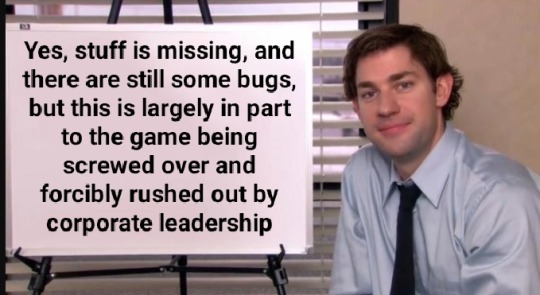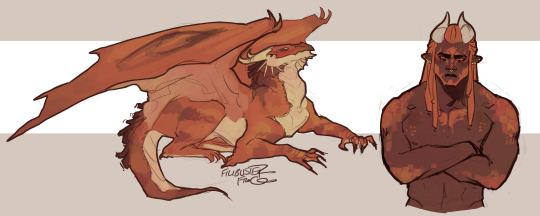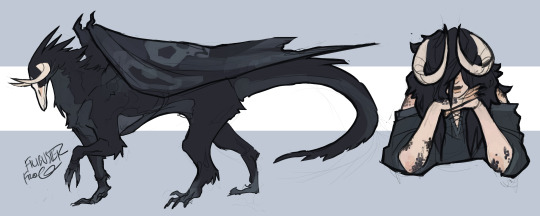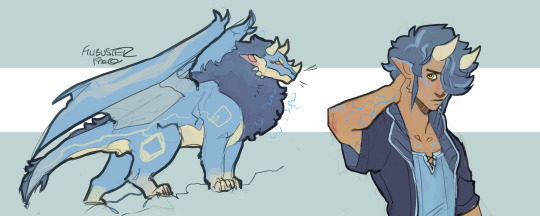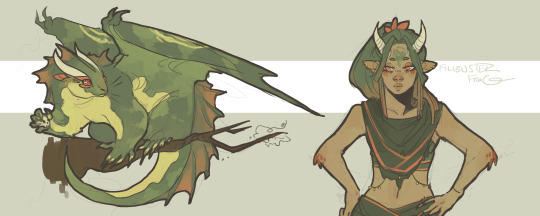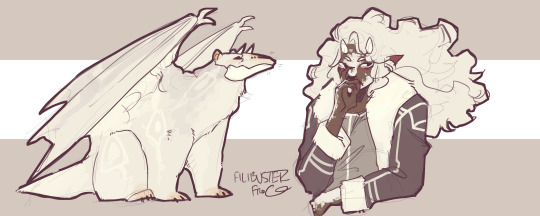Follow me on my journey to develop my very own Science Fantasy setting in the expansive Infinite Horizon! A place between places, where what you are is a product of what you think.
Don't wanna be here? Send us removal request.
Photo

A PROPOSITION FOR NEW ALIGNMENTS
We all know the 3X3 grid of Lawful Good, Neutral Good, Chaotic Good, Lawful Neutral, True Neutral, etc.
But, let’s face it. That is a two-dimensional grid, with two axes (the Good-Evil axis and the Law-Chaos Axis). We live in three dimensions.
This is why I propose a new 3X3X3 grid in three dimensions, with each of the 27 cubes representing a different alignment. The third axis I would like to introduce is the Active-Passive Axis.
As its name implies, this third axis determines how far out of your way you are willing to go to socially enforce your alignment. The three stages of activity are, of course, Active, Neutral, and Passive.
Take, for example, an Active Lawful Good (ALG) character. This character actively seeks out lawlessness and evil and smites it. Hard. Most paladins and police detectives would fall under this alignment. By comparison, a Neutral Lawful Good (NLG) character would stop a mugging if they saw one, but wouldn’t intentionally go searching for criminals unless extenuating circumstances forced it. A Passive Lawful Good (PLG) character follows the laws of where they live and do generally good things (like praying regularly to Good deities), but their good deeds would be limited to maybe volunteering at a soup kitchen. It would take a lot for a PLG character to be moved to take action, like their lives being actively threatened.
Similarly, an Active True Neutral (ATN) character is one who actively seeks to walk the middle path, believing that extremes in any direction are bad. They will also seek to convert others to the Middle Way. Buddha is a good example of an ATN character. A Neutral True Neutral (N^3) character is neutral by way of making choices that just coincidentally don’t lead one way or another (example: the same character who refuses to take action when the party gets into a bar fight because it’s illegal then robs a bank just for fun and kills an actively-evil lich king overlord for the sake of doing good). A Passive True Neutral (PTN) character simply gives no shits about anything one way or another, and will not go out of their way to do anything.
Active Chaotic Evil (ACE) characters intentionally look to destroy things. A dragon that burns down the countryside for no other reason than because it feels like it is ACE. Neutral Chaotic Evil (NCE) characters would attack adventurers that stumble into their abode, but would not actively hunt down good characters for no reason whatsoever. A Celestial-animal-hunting contest, though, would probably prod an NCE character to take action. A Chaotic Evil dragon that hasn’t done anything except sit on its family’s horde would most likely be Passive Chaotic Evil (PCE)– although it philosophically believes in chaotic and evil ideas, it isn’t really doing anything life-changing about them.
This also eliminates some moral quandaries involved with RPG games. Let’s go with the classic: you kill a bunch of male orcs and now you have to figure out what to do with the defenseless women and children. If you implement new alignment-detecting spells (Detect Active and Detect Passive, of course), it’s as simple as figuring out whether or not they’re apt to do anything actively evil. If they’re ACE, which they will be if they’re apt to seek out revenge, it’s OK to kill them and your alignment wouldn’t suffer any losses. If they’re PCE, then it’s OK to let them live, because they’re not going to do anything evil.
It also presents some very different ways to play a game. Most adventuring, fight-the-bad-guy campaigns would obviously be active, but if you’re playing a game centered around, say, becoming the best group of blacksmiths in the world, the alignments of most of your party members would be passive. It would also be interesting to start off the game with passive characters and gradually prod them into becoming active characters. Or, conversely, play as a group of retired adventurers trying to transition from the active life to the passive life.
You can, of course, also shift in alignment on the Active-Passive Axis.
What do you think about this method of assigning alignment?
345 notes
·
View notes
Text
30+ More Magical Origins...
You hatched from a giant egg.
Your material body was created by a collected amount of unconscious psychic energy.
Your mind and body are at a constant risk of being taken over by a bloodthirsty creature summoned from another dimension.
You were frozen in a glacier until your reawakening.
You were crafted as a magical being, artificially created by a lost civilization.
You come from another world.
You unknowingly participated in an illegal magical project.
You used to live in the sun.
You’re merely another poor creature that was momentarily sucked into a different dimension.
You were artificially created by otherworldly invaders as their attempt at a perfect imitation of the native race, albeit defective in some places.
You were born in a ritual involving the severed fingers of a ancient and powerful Spellcaster.
You were captured on another planet and brought here for experimentation, but manage to escape relatively unharmed.
You somehow stepped out of the weave of time and fate, when you stepped back in, hundred of years had passed, and you were met with a strange parallel world.
Your bizarre corporeal being is the living incarnation of a every person driven by anger and wild frustrations.
You were brewed into being when an open bottle of wine went bad.
You were the cherished painting of a wizard, falling into this existence one day.
You were born underwater.
You were born in complete darkness underground.
You were born in mid-air.
You’re the image of a wizard a beholder encountered and dreamed up. The magics the wizard used twisted into what the sorcerer uses today.
An arcane experiment gone awry caused a sage’s thoughts to be brought into reality. Your birth was but one of the bi-products.
One of your parents didn’t keep you at a safe distance from their experiments, the lingering magic still has a hold on you.
During a particularly cold winter’s night, you crawled forth, fully emerged, from the family fireplace.
As a young child, you were asked to hold something just real quick in the middle of a spell while the parent/teacher/etc stepped out.
You were sentenced to death for your crimes, little did they know, you merely played dead, seemingly surviving the magical execution.
You wake up from a blackout night after a feywild party. You left the party with more than you showed up with.
You got your powers from a mysterious piece of technology you found while studying the desert.
You volunteered for a strange experiment involving a sample from an unusual plant.
During a grand feast, your food and drinks were contaminated with an exotic alchemical mineral.
A strange magical creature crashed between worlds and ended up at your feet.
As a child, you created imaginary playmates that you felt truly spoke to and heard you.
You were given a potion that was supposed to cure you, it was more than you bargained for.
You were always terrified of being alone, and so began establishing links with strange and otherworldly creatures.
You were bullied throughout your life, and so made deals with outsiders to gain enough strength to fight against these oppressive forces.
This Post was made possible thanks to the contributions of our Discord Community!
275 notes
·
View notes
Text
1d8 Character Fears...
True Love. I fear true love, of being in the presence of a purity of emotional honesty that I will never know.
Famine. I have seen those who die by starvation, a death of indignity. I know how easily I too could suffer such a fate. It puts a sick feeling in my gut, one that is not easily remedied.
Deep Water. I fear the dark abyss of the Sea, the uncertainty of what lurks in those endless depths, and the writhing creatures beneath the waves that may seek to steal my soul.
The Wilderness. I fear the dark of the woods, for I have learned and made known of what dark things dwell within such places.
Cowardice. I fear being revealed a coward, that in some act of horror I will do what it is only natural and be forever shamed.
The Afterlife. I fear that upon my demise, however good or righteous it might be, that I will still be cast into the cruel and cold hands of an eternally alone and dark afterlife.
Loss of Control. I fear loss of my self, loss of my being; my face, my ego. I worked so hard to be notably myself, and to have this marred and invalidated, to look upon myself and not see me…that terrifies me deeply.
Undeath. I’ve witnessed the terrors of undeath, of spectres and skeletons, and so I fear my corpse may not stay motionless forever…
604 notes
·
View notes
Text
Here’s a little trick I’ve used in D&D games where the premise of your campaign calls for the party to have access to lots of Stuff, but you don’t want to do a whole bunch of bookkeeping: the Wagon.
In a nutshell, the party has a horse-drawn wagon that they use to get around between – and often during – adventures. This doesn’t come out of any individual player character’s starting budget; it’s just provided as part of the campaign premise.
Before setting out from a town or other place of rest, the party has to decide how many gold pieces they want to spend on supplies. These funds aren’t spent on anything in particular, and form a running total that represents how much Stuff is in the wagon.
Any time a player character needs something in the way of supplies during a journey or adventure, one of two things can happen:
1. If it’s something that any fool would have packed for the trip and it’s something that could reasonably have been obtained at one of the party’s recent stopovers (e.g., rations, spare clothing, fifty feet of rope, etc.), then the wagon contains as much of it as they reasonably need. Just deduct the Player’s Handbook list price for the item(s) in question from the wagon’s total.
2. If it’s something where having packed it would take some explaining, or if it’s something that’s unlikely to have been available for purchase at any of the party’s recent stopovers (e.g., a telescope, a barrel of fine wine, a book of dwarven erotic poetry, etc.), the player in need makes a retroactive Intelligence or Wisdom check, versus a DC set by the GM, to see if they somehow anticipated the need for the item(s) in question. Proficiency may apply to this check, depending on what’s needed. The results are read as follows:
Success: You find what you’re looking for, more or less. If the group is amenable, you can narrate a brief flashback explaining the circumstances of its acquisition. Deduct its list price (or a price set by the GM, if it’s not on the list) from the wagon’s total.
Failure by 5 points or less: You find something sort of close to what you’re looking for. The GM decides exactly what; it won’t ever be useless for the purpose at hand, but depending on her current level of whimsy, it may simply be a lesser version of what you were looking for, or it may be something creatively off the mark. Deduct and optionally flash back as above.
Failure by more than 5 points: You come up empty-handed, and can’t try again for that item or anything closely resembling it until after your next stopover.
As an incidental benefit, all the junk the wagon is carrying acts as a sort of ablative armour. If the wagon or its horses would ever take damage, instead subtract a number of gold pieces from its total equal to the number of hit points of damage it would have suffered. The GM is encouraged to describe what’s been destroyed in lurid detail.
41K notes
·
View notes
Photo

Dare: Challenge Chests
Getting to the chest was only half the test, getting it open is going to be even less straightforward
Opening treasure chests is one of the most iconic moments in d&d, as recognizable a keystone of fantasy gaming as impractical weapons, dragons hanging off of towers, and spellcasters with impractical fashion sense. Every game that apes d&d uses treasure chests in its iconography, and the addictive game design practice of “loot boxes” traces its lineage back to this archetypal aspect of the hobby.
How weird is it then that there isn’t more mechanical design surrounding these glorious vessels of gold and gain?
Oh sure, you’ve got your occasional trapped chest, and we’ve all learned the trick by now of poking any prospective chest with a stick to see if its a mimic first, but there’s a real opportunity for us dungeonmasters here to mix things up After all, almost EVERY dungeon delve features multiple opportunities to grab treasure, which means multiple opportunities to have an encounter based around the treasure itself.
Here are a few “modifiers” you can apply to chests to make them the centerpiece of an interesting encounter, though I advise only doing this once per dungeon/dungeon level, reserving it for one of the BIG treasure drops, as the extra struggle will make the reward worth it. Under the cut I’ve got a few other design ideas, including a lockpicking minigame
Challenge Chests:
Heavy: Made of metal, weighed with stone, or simply impractically large, this chest requires two people to move comfortably (or one person with goliath level strength) . Combine this reduction in functional party size with a chase scene for added tension, or force the players to test their luck with rickety bridges or thinning ice as they navigate their way out of the dungeon with their loot.
Alarming: when opened or moved this chest releases a screech or scream that deafens those nearby it while sounding the alarm for everyone nearby, effectively turning a heist into an uncoordinated ambush.
Weeping: cursed with the spirits of the drowned, this chest constantly snivels, producing a trail of brackish water that’s easily tracked. For extra fun, give it to your pirate players and inform them some time later that their ship is unexpectedly taking on water….. or suppise them as their bag of holding suddenly explodes, its capacity reached by gallons of tears.
Red handed: like the weeping chest, but this curse produces blood or dye which stains the thieves hands for days in addition to leaving a trail, perfect for identification by authorities.
Vulcan’s ire: a rune carved into this chest causes any treasure taken out of it to become instantly red hot. This will burn most delicate items while making coins and other treasures scarring to the touch. Beware of causing fires when dividing up loot at the inn, smart players will find a stone room to dump the treasure out in to let it cool before transfering to a new container.
Unlucky: whether through noise, smell, or simple misfortune, this chest causes the party to face more random encounters, attracting monsters through bad luck and foiling the party’s stealth rolls.
Wandering: This chest is actually an animated object, unintelligent, but programmed to wander off if it senses that its not being directly looked at. Likely to wander off during a dungeon if the party doesn’t send someone to babysit it, or to skulk of at night while the party is sleeping at camp, forcing the group to track it down.
Fleeting: Once removed from its place, this chest (and its contents) are on a time limit. One made of magical ice in a fire dungeon may eventually break and scatter its contents everywhere, whereas one constructed of moonlight in a fey prince’s palace returns to its place every dawn, potentially negating the entire haul.
Gooey: Alternatively sticky, slippery, or caustic to the touch, an ooze has infected the boards of this chest, making it difficult to move. Breaking the chest may inadvertently release the ooze for a fight, potentially spawning a gelatinous ooze or other harmful slime right on top of the party.
Keep reading
797 notes
·
View notes
Note
I would love to see a Monsters Reimagined on Yuan-Ti. I really like the aesthetic of snake humanoids, but the way they are described as “evil because they have no emotions by default” and the fact that they play into some of the worst mesoamerican stereotypes has always rubbed me the wrong way.

IMonsters Reimagined: Yuan-Ti
I'll admit that this one was a little bit of a challenge from a conceptual angle, in no small part because yuan-ti are one of d&d's many "monstrous humanoids" who's presence in the game is pretty much summed up by what kind of animal they are. Very specifically, they embody what western audiences THINK snakes represent: decadence, hedonism, scheming, coldness, eastern exoticism, mysticism, and evil. They are snake cultists, in that they are snakes who are part of a cult, and they are cultists who worship snakes, everything they do in the game is in some way related to cults and/or snakes, and that makes this post more of a full on reinvention than a simple reinterpretation.
That said, I love both challenges AND chances for me to give my opinion on things, so I'm happy to share my top to bottom thoughts on the serpentfolk beneath the cut. For now, the TLDR is that if you want to do something interesting with them, use the snake-cult transformation gimmick, but set it in the past, meaning that modern day Yuan-Ti are the descendants of heretics, visibly marked out as untrustworthy much in the same way that tieflings are. Some may lean in to this sinister reputation, while others attempt to hide it. Others use their hypnotic charm to carve out a place for themselves as courtiers, merchants, hucksters and influencers.
What's wrong: Much like orcs, Yuan-Ti were a pulp-adventure monster made to decouple tropes about exotic and sinister eastern spiritualities from any one particular culture. They were the default enemies to throw in if you needed fodder for a forgotten desert/jungle temple, and they rode the snake gimmick HARD, having traps, weapons, buildings, minions, cultures and religions all built around snakes. Yuan-ti culture went about as deep as finding an excuse to capture players and stick them to an altar for sacrifice, and most authors left it at that.
The more recent interpretation of Yuan-Ti ( present in Volo’s guide) paints them as a priestly faction of a bronze-age human empire that unlocked a process to transform themselves into a “more evolved” form. The transformation requires human sacrifice, but specifically makes them smarter, which creates a feedback loop where great technological and magical advancement leads to territorial expansion, which in term leads to more slaves to fuel the yuan-ti’s evolutionary process. I’m not going to lie, this is some great worldbuilding, and is certainly something that fits into a fantasy bronze age. The problem occurs that despite thousands of years passing canonically since the rise and fall of the serpent empire, the Yuan-ti are STILL AT IT, huddling in their decrepit temples and having made 0 social or technological process. Despite their updated lore, they still only exist to bushwack heroes traveling through equatorial wilderness and provide minions for greater campaigns.
it’s also weird to me that the Yuan-ti are singled out as if they were a particularly wicked force in history as nothing about the ancient yuan-ti empire was particularly more brutal than any IRL culture of a comparative era. Expansion, conquest, exploitation, and enslavement is what empires DO, regardless of whether their priesthood happens to be cold-blooded or not. The fact that the rich and powerful of that era would sacrifice others for their own benefit is just a given, and the fact came along with a scaled transformation and “physical perfection” is no different than a feudal lord going to war for plunder, or a modern tycoon overworking his employees to afford a new yacht.
As D&D baddies go, Yuan-Ti are odd in that they somewhat subvert the the “always chaotic evil” trope by not being spiritually compelled to do evil the way orcs or gnolls are. Instead, they’re universal sociopaths and their culture is just laser focused on the “Other people aren't actually people” angle. Nevermind that a culture like this couldn’t actually sustain itself, as civilization is only sustained by people working together, compromising, and caring about one another.
How do we Fix this: I think a lot of yuan-ti lore can be salvaged by thinking of them less as a “race” and more as the biproduct of a particular magical tradition that leaves a mark on practitioners and their descendants. Likewise, I think we can say that the “ emotionless cruelty” is more a styereotype about the serpentfolk given the callousness of their progenitors: the original Yuan-ti were sociopaths because sociopaths seek powerful positions, and people in powerful positions would have the resources required to perform the transformation into yuan-ti.
We also should change how the transformation works: the basic level of yuan-ti ( the pureblood) are the “intended” results of the transformation ritual, as this ritual requires no human sacrifice. All the other forms known are biproducts of a perversion of the ritual by using more life energy, which explains why the end results are so varied, and why they carry names like “ Abomination” and “ Anathama”. Those who are born purebloods/willingly transform into them carry this bloody legacy however, and the suspicion of those who remember the legends of the original Yuan-ti’s cruelty.
There’s also a lot of fun things that can be done with the legacy of the serpent empire itself, and I encourage you to mix/match any of these options as they provide adventure hooks/lore for your own setting.
The yuan-ti priesthood were smart, and when their empire crumbled ( as all empires do), those that survived the retribution of the peoples they had oppressed offered their services to the kingdoms and warlords that arose to fill the power vacuum. Respected due to their intellect and powers, but distrusted due to their previous crimes, the serpentfolk settled into the positions of sages, courtiers, and royal mages, jealously guarding the secrets of their transformation as would any mystic sect. In this way they have endured the turning of ages, at once separate from the people of their former empire, and subtly interwoven with them.
Every so often, someone discovers the lost lore of the serpent lords and attempts to claim a little of their power for themselves. Perhaps it is a pureblood descendant looking to reclaim their “birthright”, perhaps it is a sage reading ancient tomes hungry for the revelations of metamorphosis. Either way, this allows for Yuan-ti to pop up without warning, and can be used in a thematically similar way to someone trying for lichdom.
Seeing the fall of their domain, some serpentlords fled into the far wilderness, in order to create isolationist enclaves and maintain their power. THESE are where you get the hypertradionalist “ snake supremacy” sort of people, but they should be treated exactly like you would cult enclaves in our own world. Interestingly enough this gives yuan-ti players a chance to indulge in religious trauma narratives, except with snake-gods swapped in for offbrand Christianity.
There’s nothing the rich and powerful want more than being immortal, so lets say that some of the Yuan-ti elders figured out a way to do that ( possibly by reaching Anathema status). These elders would continue to exert cultural influence ( with the case of the court mages or enclaves options) or might have sealed themselves away in tomb-like strongholds for generations long hibernation. Awakening to find they’re no longer the dominant force in the world might not be a reality these regal reptiles could comprehend, so expect them to lash out at presentday authorities or try to reassert their positions from within.
On Deities: While I’ve got more than a few problems with how d&d does its gods, I think they’re all present in how yuan-ti religion is handled. Namely, the serpentfolk religion is less an ethical philosophy or belief system, and more a transactional pact between the sacrifice providing cultists and an ever hungry cosmic being that grants them powers in return. Volo’s guide points to this being a byproduct of their ego and inability to feel emotions like devotion or reverence, but mechanically it’s almost identical to how every other religion in the default setting works.
With Yuan-ti being so tied up with their religion, I figure it’s a good idea to give their gods a refurbishing like I did to Orcus, turning them from placeholders into real ideologies that people would actually want to worship, even if they were evil:
Merrshaulk: The default god for temple lurking Yuan-ti, the origin of all the sacrificial snake transformation rituals, currently in a millennia long hibernation where as his followers want to wake him and reassert their power over their empire. I’d go one step further and say that this was the patron god of the bronze age city-state that the Yuan-ti originated in, who was in-turn served by the priesthood who popularized the metamorphosis. Just like his followers, Merrshaulk began as a very basic humanoid god, and came to resemble a great snake more and more as the culture that supported him was transformed. This transformation from harvest deity to a man-eating god of imperium to all-devouring serpent in response to his follower’s desires makes for a great addition to any mythology, and provides a lot of texture to a setting where the serpentfolk feature.
Dendar: The “Night serpent” is one of the most amazing parts of default d&d lore that no one ever told me about; a titanic snake that arose from the first mortal dreams and has been devouring the multiverse’s collective nightmares ever since? METAL AS FUCK. For some reason ( likely because the authors were trying to create yet another all consuming big bad,) Dendar’s goal is to eat enough nightmares to one day manifest and devour the world. Eh... pretty cliché if you ask me. Why not lean into the ragnarok influence and say that Dendar will emerge to eat the world when there isn’t enough nightmares for her to eat, leading some of her most zealous followers to create nightmares in the hopes of sating their world devouring patron. Whether these fear-bringers are justified or totally misguided, it makes for a waaaay more interesting story.
Pharika: You couldn’t ask for a more serendipitous coincidence than for a whole other game to develop a snake based god of healing, transformation, and affliction, then for that game to lend it’s setting to d&d. Pharika SHOULD be the patron goddess of the Yuan-ti, as her mythology already has her filling the world with secret knowledge that her followers must learn to understand. Whether through the process of alchemy, medical service, or experementing on the bodies of other creatures, having Pharika as a patron gives the serpentfolk an amazing, thematically rich patron the way that dwarves have the Allhammer, or elves have the Archheart
Art
754 notes
·
View notes
Photo
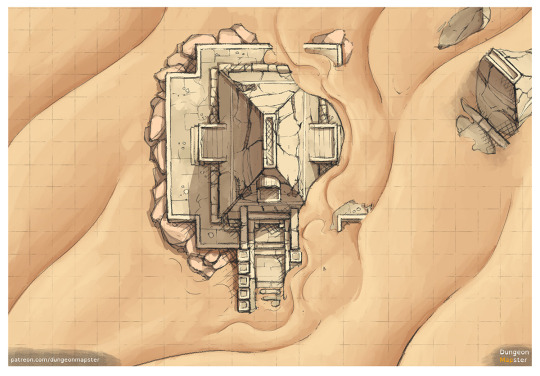
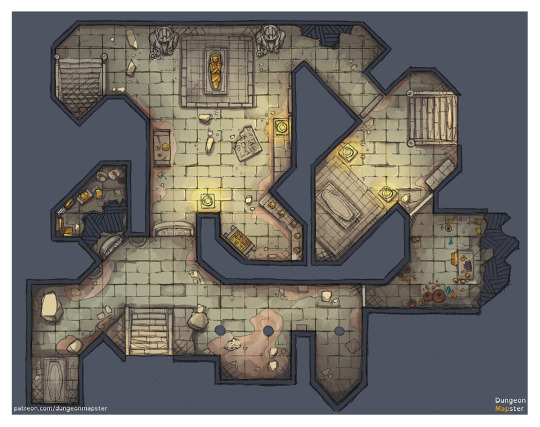
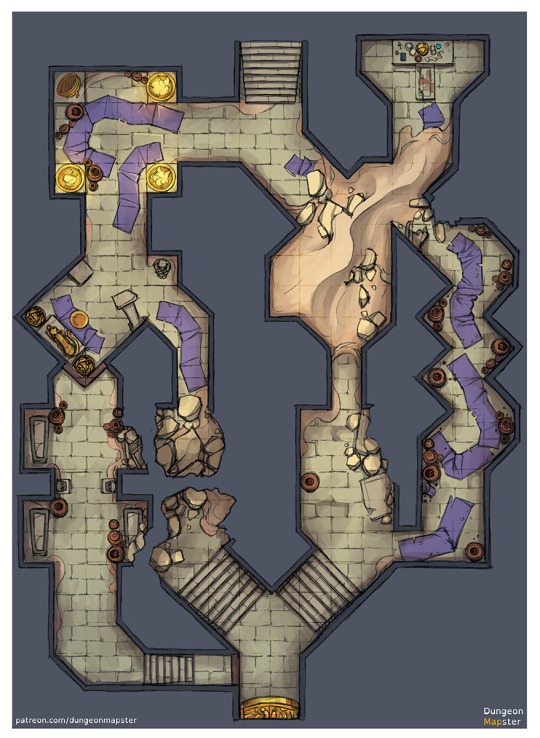
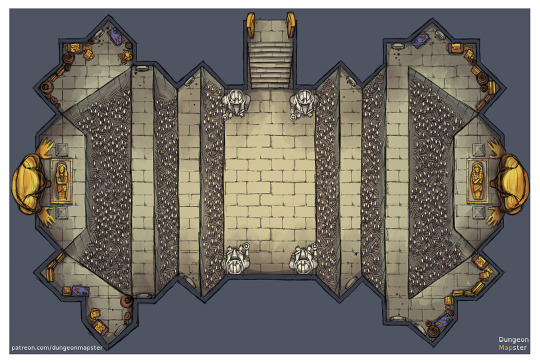
Downloads, hi res, gridless, etc, are available on my patreon www.patreon.com/dungeonmapster
The centuries have slowly eroded and decayed this place, stone halls collapsing under thousands of pounds smooth, velvety fine sand that falls in thin trickling bursts from the cracked ceilings with each step. That dark ritual took place here, so many years ago, and why did the architects of this last resting place position traps and dangers, in addition to those made by the threat of collapsing passages? One thing is certain. The path below must be tread carefully, if one does not desire to join the occupants here, sealed below the shifting sands…
Instagram
Twitter
340 notes
·
View notes
Note
SAAAAAAAAME
frob are you doing something for pride month?
my birthday
312 notes
·
View notes
Text
This is incredible work!








A D&D Party and their BBEG, Caax. Commissioned by Fandangoh!
80 notes
·
View notes
Photo
Yo! Great drawing. Gets a lot of detail across without overcomplicating things and making it look messy.

Not sure if I posted this or not (if it was, it was a while ago), but this is The Falcon, a ship I designed for my PCs to adventure around in. Key highlights:
A: the grid in the centre of the ship are removable shutters that can be moved to allow cargo to be put below in the hold. The ship’s anchor is affixed to the bow of the ship, mimicking a falcon’s hooked beak.
B: the captain’s working cabin.
C: the symbol of the falcon at the front is actually a table for the crew with the ship’s moniker carved into its surface.
D: bilges are really gross. :)
I illustrated this in Photoshop over a grid I created to dungeon-making. It was cool being able to hand this to the PCs for them to get a sense of what The Falcon was all about.
- Mo!
204 notes
·
View notes
Photo
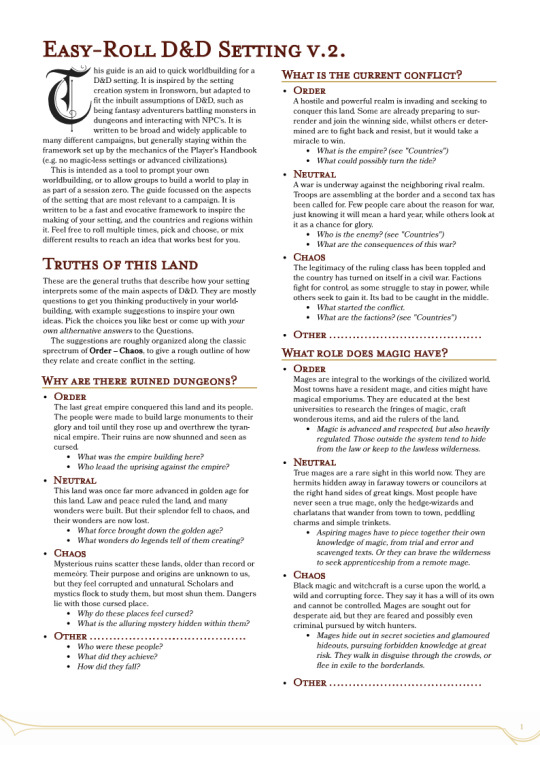
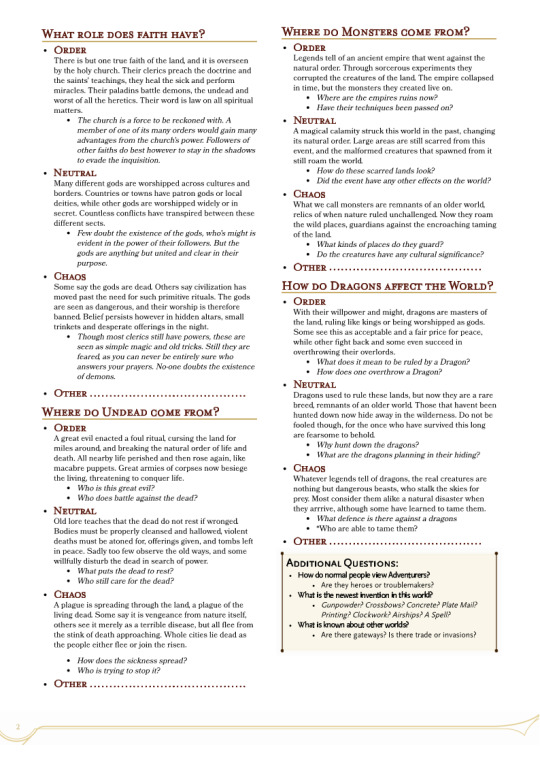


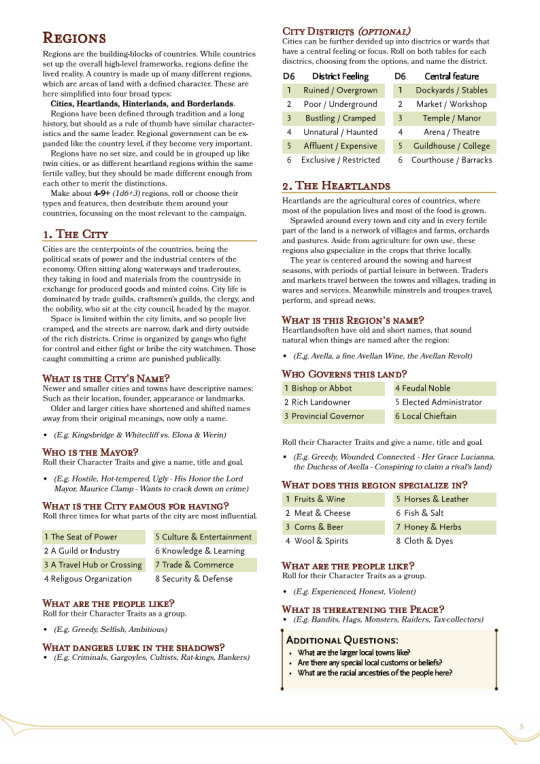

Here is the revised and expanded version of my Easy-Roll D&D worldbuilding guide, a fast and evocative guide to worldbuilding and creating a setting for D&D. Broken up into sections about the world in general, countries and regions, the guide asks questions with suggestions to inspire your imagination along the worldbuilding topics that are most relevant to creating a D&D setting.
(Source link)
(PDF link)
205 notes
·
View notes
Text

hewwooo guys my 19 y/o sibling (the other screaming one you’ve heard in the rwby reacts with me occasionally) is trying to save up for a car so I wanted to share their commission info here!! No worries if you can’t donate but a boost would be much appreciated💜
insta is @digitalpuff
74 notes
·
View notes
Text

I got my package from @skirtzzz yesterday! Only just now had the opportunity to open it up and take a look at all the beautiful prints and stickers! Not to mention enjoying the valentine and thank you cards she sent along with the package. :)
Dunno how many people out there will see this, but if you do, and you haven't checked out her store, go do it now! She's such a talented artist, and puts so much love into her packages as well, (the little paper hearts are adorable). She definitely deserves all the love and support she can get!
#skirtzzz#not my art#wonderful artist#that was the only valentine i got this year#it made my day though
3 notes
·
View notes
Photo










The amazing concept art of Jeong H. Shin for For Honor
For Honor
2K notes
·
View notes
Text
“May I please draw your OC?”
Reblog this message if you encourage anyone that wants to draw your OC to do so. No need to ask for permission in advance.
Go for it. Draw my OC. If you want, I’ll even give you reference posts. Go to town on it.
You are welcome to draw my OC and surprise me with the result. Seriously. In fact, I encourage it. I will proudly display whatever it is you submit to me regarding my OC. There is a chance that I will squeal about it for several days.
Even if you feel you aren’t good at whatever artistic adventure it is you do, please feel free to submit it to me. I want to see what you have done.
136K notes
·
View notes





